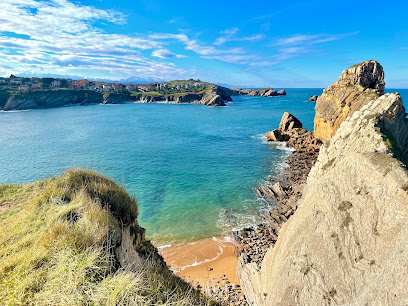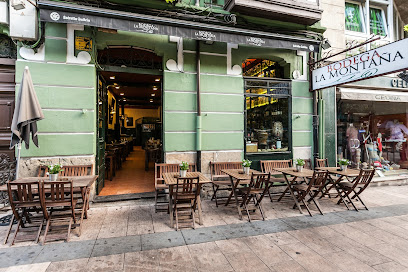
Urro del Manzano: A Natural Wonder in Cantabria
Discover the breathtaking cliffs and stunning vistas of Urro del Manzano, a natural treasure of Cantabria perfect for adventure and relaxation.
Urro del Manzano is a breathtaking natural attraction in Cantabria, Spain. Known for its striking coastal cliffs and stunning views, it’s the perfect spot for tourists seeking adventure and scenic beauty.
A brief summary to Urro del Manzano
- Cantabria, ES
- Monday 12 am-12 am
- Tuesday 12 am-12 am
- Wednesday 12 am-12 am
- Thursday 12 am-12 am
- Friday 12 am-12 am
- Saturday 12 am-12 am
- Sunday 12 am-12 am
Local tips
- Visit during sunrise or sunset for the most breathtaking views and perfect lighting for photography.
- Wear sturdy hiking shoes as some trails can be uneven and steep.
- Bring a picnic to enjoy while taking in the spectacular coastal scenery.
- Check the weather forecast before your visit as conditions can change rapidly along the coast.
Getting There
-
Car
If you are driving, start on the A67 highway. From there, take the exit toward N-611 direction Torrelavega. Continue on N-611 until you reach the exit for N-634 toward Unquera. Follow N-634 until you see the signs for Urro del Manzano. The site is well-marked and is approximately 30 minutes from Torrelavega.
-
Public Transportation
To reach Urro del Manzano via public transport, take a bus from Santander to Torrelavega. Buses run frequently and the journey takes about 30 minutes. From Torrelavega, you will need to take a taxi to Urro del Manzano, as public transport options from Torrelavega to the attraction are limited. Expect to pay around 15-20 euros for the taxi ride, which will take approximately 30 minutes.
-
Walking
If you're feeling adventurous and are staying nearby, consider walking to Urro del Manzano from the surrounding areas. The paths are marked, but ensure you have a good map or GPS as the terrain can be rugged. Walking from the nearest town you find yourself in may take over an hour, depending on your exact starting point.
Discover more about Urro del Manzano
Iconic landmarks you can’t miss
Ermita de la Virgen del Mar
3.9 km
Discover the serene beauty of Ermita de la Virgen del Mar, a historic church in San Román de la Llanilla, offering breathtaking views and spiritual tranquility.

Museo de Arte Moderno y Contemporáneo de Santander y Cantabria
9.3 km
Explore contemporary creativity at the Museo de Arte Moderno y Contemporáneo de Santander y Cantabria, a hub of modern artistic expression in Spain's stunning Cantabria region.

Parroquia de la Anunciacion
9.6 km
Discover the enchanting Parroquia de la Anunciacion, a must-visit church in Santander, blending architectural beauty with rich cultural heritage.

Plaza Porticada (plaza de Velarde)
9.7 km
Discover the vibrant heart of Santander at Plaza Porticada, a historical landmark perfect for leisure and cultural experiences in Cantabria.

Estatua de Pedro Velarde
9.8 km
Explore the historic Statue of Pedro Velarde in Santander, a tribute to courage and a symbol of Cantabria's rich heritage.

Mirador Rio de la Pila
9.8 km
Discover stunning panoramic views of Santander and the Cantabrian coastline at the Mirador Rio de la Pila, a must-visit observation deck.

Monumento al Incendio de Santander
9.8 km
Discover the Monumento al Incendio de Santander, an inspiring memorial that honors the resilience of this remarkable city after a devastating fire in 1941.

Panteón del Inglés
9.9 km
Discover the serene Panteón del Inglés in Cueto, a picturesque shrine blending history and tranquility, perfect for reflection and exploration.

Mercado del Este
9.9 km
Discover the flavors and crafts of Cantabria at Mercado del Este, Santander's lively market filled with local delicacies and artisanal treasures.

Paseo de Pereda
10.0 km
Experience the stunning Paseo de Pereda, where scenic views, vibrant culture, and local delights await in Santander, Spain.

Fuente de Concha Espina
10.0 km
Explore the Fuente de Concha Espina in Santander, a stunning memorial honoring a literary icon amidst lush gardens and vibrant city life.

Grúa de Piedra
10.0 km
Explore the historical significance of Grúa de Piedra, a maritime landmark in Santander, where history meets breathtaking coastal views.

Plaza de Pombo
10.1 km
Discover Plaza de Pombo, Santander's lively square filled with cafes, culture, and a vibrant atmosphere perfect for relaxing and exploring.

Los Reginas Santander
10.1 km
Discover the breathtaking Cantabrian coastline with Los Reginas, Santander's premier boat tour agency offering unforgettable maritime experiences.

Placa a María Blanchard (Ilustres Santander)
10.3 km
Explore the enchanting Placa a María Blanchard, a historical landmark in Santander that embodies the city's rich cultural heritage and artistic spirit.

Unmissable attractions to see
Urros de Liencres
0.3 km
Experience the breathtaking beauty of Urros de Liencres, a stunning coastal attraction in Cantabria, Spain, with unique rock formations and serene landscapes.

Bufon del madero
2.0 km
Explore the breathtaking Bufon del Madero, a natural blowhole in Cantabria, where the ocean's power meets stunning landscapes.

Playa Virgen del Mar
4.0 km
Experience the breathtaking beauty and tranquility of Playa Virgen del Mar, a stunning public beach in Santander known for its golden sands and azure waters.

Dunas de Liencres
4.5 km
Discover the stunning landscapes and rich biodiversity of Dunas de Liencres, a natural gem along the coast of Cantabria, Spain.

La Maruca
7.1 km
Discover tranquility at La Maruca, a stunning park in Santander offering breathtaking coastal views and a perfect escape into nature.

Doctor Morales Park
7.3 km
Experience the tranquility of Doctor Morales Park in Santander, a perfect escape with lush greenery and family-friendly amenities.

Marismas de Alday (A)
8.2 km
Explore the tranquil Marismas de Alday in Cantabria, a park rich in wildlife and breathtaking scenery, perfect for relaxation and outdoor activities.

City Sightseeing Santander
8.8 km
Discover Santander's beauty and history with City Sightseeing Tours, offering hop-on, hop-off convenience and unforgettable views.

Tour Santander
9.4 km
Discover the captivating charm of Santander with expert-guided tours showcasing its rich history, stunning coastal views, and vibrant culture.

Plaza del Ayuntamiento
9.4 km
Discover Plaza del Ayuntamiento, a vibrant hub in Santander where history, culture, and local life beautifully converge.

Cueva El Pendo
9.7 km
Explore Cueva El Pendo, a stunning cave in Cantabria, renowned for its ancient rock art and breathtaking geological formations that captivate every visitor.

Monumento a Nuestra Señora de la Asunción
9.7 km
Visit the Monument to Our Lady of the Assumption in Santander, a stunning sculpture celebrating art, culture, and history in a vibrant Spanish city.

Catedral de Santander
9.7 km
Explore the grandeur of Catedral de Santander, a historical Catholic cathedral rich in art and culture, located in the heart of Spain's beautiful Santander.

Plaza Alfonso XIII
9.7 km
Discover the vibrant art and lively atmosphere at Plaza Alfonso XIII, the cultural heart of Santander, where creativity and community come together.

Muralla de Santander
9.8 km
Discover the captivating history and stunning views at the Muralla de Santander, a must-visit historical landmark in Cantabria.

Essential places to dine
Bar Restaurante El Cazurro
0.7 km
Experience authentic Mediterranean cuisine at Bar Restaurante El Cazurro in Cantabria – where every meal is a celebration of flavor.

Restaurante la Tucho
4.8 km
Discover exquisite seafood dining at Restaurante la Tucho in San Román de la Llanilla – where Mediterranean flavors meet Cantabrian tradition.

Restaurante La Ventana
5.1 km
Experience authentic grill cuisine in Santander at Restaurante La Ventana, where every meal is a celebration of flavor and ambiance.

Restaurante Las Olas
7.2 km
Experience exquisite seafood and traditional rice dishes at Restaurante Las Olas in beautiful Monte, Cantabria.

Restaurante Gelín
7.7 km
Experience authentic Cantabrian flavors at Restaurante Gelín in Santander - a family-friendly haven for tapas and traditional Spanish cuisine.

Restaurante La Candelita
7.7 km
Discover authentic Mediterranean and Spanish cuisine at Restaurante La Candelita in Santander, where every dish tells a story.

El Nuevo Molino
7.8 km
Experience exquisite fine dining at El Nuevo Molino in Cantabria, where local flavors meet culinary artistry in an elegant setting.

Restaurante Casona Del Judio
7.8 km
Discover exquisite Cantabrian cuisine at Casona Del Judio - where every dish is a masterpiece in fine dining.

Restaurante Santlivis sl
8.1 km
Discover the essence of Cantabrian cuisine at Restaurante Santlivis in Santander - where tradition meets modernity.

Taberna La Prensa Restaurante
8.2 km
Discover fresh seafood delights at Taberna La Prensa in Santander – where every dish tells a story of Cantabrian tradition.

Restaurante La Galerna
8.5 km
Experience authentic Mediterranean cuisine at Restaurante La Galerna in Santander - where fresh flavors meet warm hospitality.

Bodega La Montaña
8.6 km
Experience authentic Cantabrian cuisine at Bodega La Montaña in Santander – where tradition meets taste in every dish.

Restaurante Manil
8.6 km
Discover authentic Mediterranean and Spanish cuisine at Restaurante Manil in Santander, where every meal is a celebration of flavor and culture.

Taberna La Radio
8.7 km
Experience authentic Cantabrian seafood cuisine at Taberna La Radio in Santander – where fresh flavors meet warm hospitality.

Restaurante Los Peñucas
8.9 km
Experience authentic Cantabrian seafood at Restaurante Los Peñucas in Santander - where fresh flavors meet warm hospitality.

Markets, malls and hidden boutiques
El Corte Inglés Santander
8.0 km
Discover a world of shopping, dining, and entertainment at El Corte Inglés Santander, the ultimate destination for tourists in Cantabria.

Centro Comercial Bahía de Santander
8.0 km
Explore the Centro Comercial Bahía de Santander: your go-to shopping destination in Cantabria with diverse shops, cozy cafes, and a lively atmosphere.

3MSTYL
8.3 km
Explore the latest fashion trends at 3MSTYL in Santander, where style meets affordability in a chic shopping environment.

Almacenes Mariana
8.3 km
Explore Almacenes Mariana for a unique and stylish shopping experience in Santander, where fashion meets local charm.

El Colmado Santander
8.3 km
Discover the best of organic produce at El Colmado Santander, where local flavors meet health-conscious choices in a charming setting.

Bazar Chino Xin Xin I
8.3 km
Explore the vibrant and eclectic offerings of Bazar Chino Xin Xin I, a gift shop in Santander that showcases local culture and unique souvenirs.

Distrito Zero
8.3 km
Explore Distrito Zero in Santander for an unforgettable trading card experience, where collectors and enthusiasts unite in a vibrant atmosphere of cards and camaraderie.

Cadeneta
8.3 km
Discover the vibrant world of wool at Cadeneta, Santander's premier wool store offering exquisite yarns and handcrafted garments.

Los Secretos de mamá
8.4 km
Explore your desires at Los Secretos de Mamá, Santander's premier adult entertainment and lingerie store, where quality meets passion.

Le vélo
8.4 km
Explore unique fashion at Le Vélo, a stylish clothing store in Santander that captures the spirit of Cantabria's vibrant culture.

Lola Méndez Santander
8.4 km
Explore the unique fashion offerings at Lola Méndez Santander, where style meets local charm in the heart of Cantabria.

Bus Stop
8.5 km
Explore Bus Stop in Santander for unique women's fashion and exquisite costume jewelry that captures the spirit of style and elegance.

CARTAGO
8.6 km
Discover CARTAGO in Santander, a vibrant fashion accessories store offering trendy clothing and unique items for every style.

Unique Vintage Home
8.6 km
Explore Unique Vintage Home in Santander, where timeless elegance meets modern living with a curated selection of vintage-inspired home goods.

La Barata Santander
8.6 km
Experience the vibrant fashion scene at La Barata in Santander, where trendy clothing meets exceptional style and affordability.

Essential bars & hidden hideouts
Bar Cuadros
7.9 km
Discover the vibrant nightlife of Santander at Bar Cuadros, where locals and tourists mingle over affordable drinks and warm hospitality.

Bar Jamaica - Santander, Cantabria
8.3 km
Experience the flavors of Cantabria at Bar Jamaica, where delicious tapas and refreshing drinks await in a vibrant setting.

Rock Beer The New
8.9 km
Discover the vibrant atmosphere of Rock Beer The New, a piano bar and concert hall in Santander offering live music and affordable drinks in a welcoming setting.

Bar la Crisis
8.9 km
Discover the heart of Santander's nightlife at Bar la Crisis, where local flavors meet a vibrant atmosphere for all beer and espresso lovers.

Speakeasy Bar
9.4 km
Experience the allure of the Prohibition era at Santander's Speakeasy Bar, where innovative cocktails and a vibrant atmosphere await.

Pub La Buhardilla
9.5 km
Discover the energetic vibe of Pub La Buhardilla in Santander, where rock music meets a social haven for unforgettable nights out.

Bolero
9.7 km
Discover Bolero, Santander's vibrant live music bar, where unforgettable nights meet local culture and lively performances.

1769 Pub Santander
9.8 km
Discover the vibrant nightlife of Santander at 1769 Pub, a lively piano bar featuring live music, crafted cocktails, and a warm, inviting atmosphere.

Bull Santander
9.8 km
Discover the lively nightlife at Bull Santander, where great drinks and a vibrant atmosphere await every visitor.

Bramble Cocktail Bar
9.8 km
Bramble Cocktail Bar: Your go-to destination in Santander for expertly crafted cocktails and a vibrant nightlife experience.

SOHO Bar Gallery
9.8 km
Discover SOHO Bar Gallery in Santander, where local art meets vibrant nightlife in a unique bar setting.

La Floridita
9.9 km
Experience the vibrant nightlife of Santander at La Floridita, your go-to cocktail bar for expertly crafted drinks and a lively atmosphere.

La Chica de Ayer
10.0 km
Experience the lively atmosphere and local flavors at La Chica de Ayer, Santander's must-visit pub for an unforgettable night out.

El Mono que Chilla
10.0 km
Experience the vibrant nightlife of Santander at El Mono que Chilla, where delicious drinks and a lively atmosphere await.

Bar Rvbicón
10.0 km
Experience the vibrant nightlife of Santander at Bar Rvbicón, a cozy bar offering a delightful selection of drinks and a warm atmosphere.




